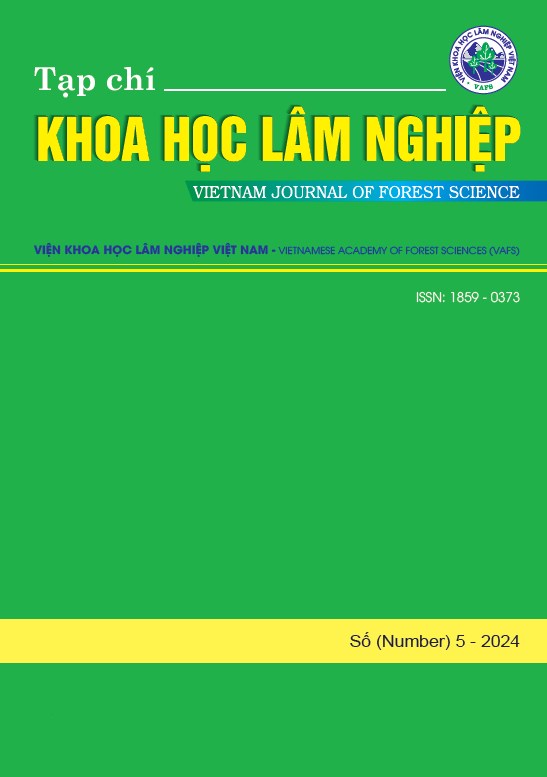To evaluate the recovery ability of evergreen broadleaf forest after logging in Krong Pa Forestry Company, Kbang district, Gia Lai province
DOI:
https://doi.org/10.70169/VJFS.980Keywords:
Recovery after logging, Evrgreen broadleaf forest, Structure, Regeneration, Krong pa company.Abstract
The production forests have been extensively logged that need to be best managed to facilitate the recovery progress. Evaluating the recovery capacity of degraded forests can provide appropriate silvicultural technical measures to promote the recovery process and contribute to improving forest quality and sustainable development. The study was carried out at Krong Pa Forestry Company, Gia Lai province. The aim of this study was to assess the recovery capacity of Evergreen forest after 12 years of extensive logging. We assessed the following factors: The density structure, species composition structure, regeneration, storey structure and growth indicators, and distribution characteristics: N/D1.3, N/Hvn. Seven circle 1000 m2 (R = 17.84 m) plots were setup by random method. Results showed that the density of hight trees varied from 350 – 830 trees per hecta. Tree species varies from 9 to 44 species with four dominant species. Forest structure consists of three storey, which are A2, A3 and B. The average height of woody species is 12.3 m, while the average DBH is 22.1 cm and the average yield is 256.099 m3 per hecta. N/D1.3 and N/Hvn distributions showed a decreasing form.
References
Bộ NN&PTNT, 2024. Đề án :Đầu tư bảo vệ và phát triển rừng hỗ trợ các địa phương ứng phó với biến đổi khí hậu và bảo đảm quốc phòng, an ninh vùng Tây Nguyên giai đoạn 2024 -2030”.
Bộ NN&PTNT, 2024. Quyết định số 816/QĐ-BNN-KL ngày 20/3/2024, Công bố hiện trạng rừng toàn quốc năm 2023
Bộ NN & PTNT, 2023. Thông tư số 16/2023/TT-BNNPTNT ngày 15/12/2023. Sửa đổi, bổ sung một số điều của Thông tư số 33/2018/TT-BNNPTNT ngày 16/11/2018 của Bộ trưởng BNN&PTNT quy định về điều tra, kiểm kê và theo dõi diễn biến rừng.
Bảo Huy, 2017. Tin học thống kê trong lâm nghiệp. Nxb. Khoa học và kỹ thuật, Tp. HCM, 282p.
Bảo Huy và Nguyễn Thế Hiển, 2021. Hướng dẫn kỹ thuật phục hồi rừng tự nhiên. Tropenbos Việt Nam.
Phùng Ngọc Lan, 1986. Lâm sinh học. Nxb. Nông nghiệp. Hà Nội, 120p.
Lê Cảnh Nam, Nguyễn Thành Mến, Hồ Ngọc Thọ và Bảo Huy, 2020. Ảnh hưởng của các nhân tố sinh thái đến mật độ phân bố Thông 5 lá ở Tây Nguyên. Tạp chí Khoa học Lâm nghiệp, số 1/2020: 62-72.
Thái Văn Trừng, 1978. Thảm thực vật rừng Việt Nam. Nxb. Khoa học và Kỹ thuật, 276p.
Daniel Marmillod, 1982. Methodology and results of studies on the composition and structure of a terraced forest in Amazonia. Doctorate. Georg - August - Universität Göttingen., Göttingen.









